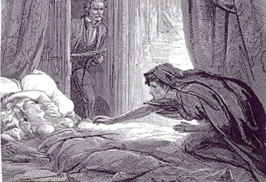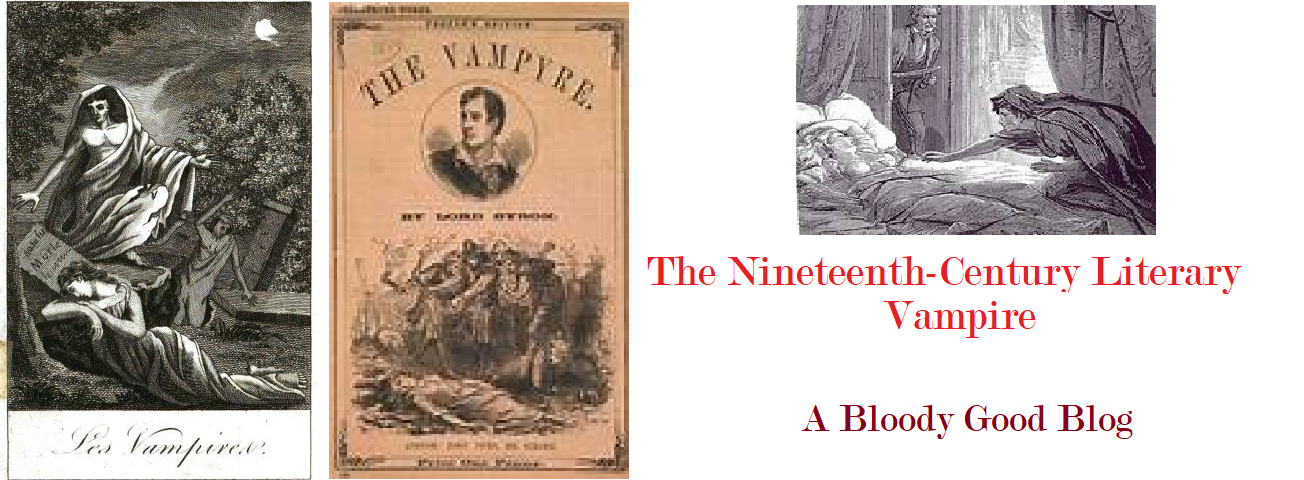Why are vampires bad artists? Because they always want to draw blood! Ha, ha, ha, ha, get it?

All jokes aside, vampires are creatures that will always live in literature and media. While vampires are always evolving, they are consistently used as pawns to address fears that the creator has about their current society. Society’s fears of being alone are represented in the novella Carmilla (1872) by Joseph Sheridan Le Fanu and the television series What We Do in the Shadows (2014). Let’s sink our teeth into this!
Carmilla was written by Irish author Le Fanu in 1872 to address the fear of women not needing men. [NR1] At the same time, the Irish Women’s Suffrage Society had just come into existence, in hope to achieve voting equality. Le Fanu who saw women[NR2] clawing for equality. Carmilla is a story that shows the fear that Le Fanu, and society, had of women going wild, or independent, and not needing men. LeFanu speculates that women will follow only their emotions, with terrible results. “Young people like, and even love, on impulse” (Le Fanu 17) is just one of many examples of Laura, the story’s main character, being written to imply she can only operate on emotions. As the story progresses, Laura ignores multiple instances of weirdness around her lover Carmilla and, only with the help and knowledge of men, is free from the evil vampireCarmilla. The story shows Le Fanu’s mindset that women cannot make wise choices on their own. In this being a lesbian relationship, Le Fanu is treating the fear of men not being needed romantically by giving the males a happy ending; the lesbian monster is killed by the men. In choosing Carmilla to be the monster in the story, Le Fanu both implies that women will not be smart leading their own relationships and that, really, only the unstable would pursue a lesbian relationship. After all, Laura is shown as weak and lonely while Carmilla is a vampiric monster only manipulating emotions for her own good. At the end of the story, Laura ends up alone and Carmilla is horrifically decapitated so she exists no more. Carmilla reminds men that women won’t be able to replace them while sending women the message that they need men and that lesbian relationships should be feared. In trying [NR3] expressing his own fears, Le Fanu created some for others.

Carmilla next addresses the fear of the unknown. According to critic Lin Young’s reading, “[t]he vampire produces horror in the men…with respect to how permeable all forms of knowledge and specifically all definitions of social and biological categories are” (Young 77). There is much mystery around Carmilla’s character, both at the time of her arrival and after she has been slain. Laura, who was closest with Carmilla as, perhaps, her friend then lover doesn’t even get close to knowing who Carmilla really was. Laura writes. “The image of Carmilla returns to memory with ambiguous alterations,” Le Fanu states, “sometimes [NR1] the playful, languid, beautiful girl; sometimes the writhing fiend I saw in the ruined church” (LeFanu 63). Literally everyone ends up confused the more they learn about Carmilla. According to Young, “Carmilla remains, throughout the text, socially, romantically, and sexually unexplainable” (Young 70). To tackle that fear, Le Fanu chooses to format Carmilla as a medical report. In choosing this method of telling the story, Le Fanu comforts readers by implying that, even when science cannot fully explain what is happening, scientific data will be gathered and studying will happen to prevent the horrors from repeating. The cherry on top is that, at the very least, Carmilla was defeated permanently; therefore the fear has been faced.
Now. fast forward to 2014. This is the year the movie What We Do in the Shadows was released. In 2014, the internet is around, online dating is live, sex is happening, and the world is adapting to this. What We Do in the Shadows addresses the modern fears of not being able to find a romantic partner through the vampire character Viago. The film says that Viago had a human love that he was following to New Zealand, with the intent to change her into a vampire. Sadly, due to the wrong postage on his coffin, Viago arrives late and his love has found someone else; a human no less! Viago is heartbroken, and lives a “miserable existence, wherein the much-hyped vampire sex becomes eternal loneliness with random joys of masturbating in a coffin with the photo of the beloved woman” (Limpár 274). By the end of the movie, Viago is reunited with his love; she is still human and has aged greatly, so greatly that she is in a senior home. When reunited, she agrees to let Viago change her to a vampire and the two are a couple again. Upon reflecting on this, Viago says: “Some people freak out a bit about the age difference. They think, “What’s this 96-year-old lady doing with a guy four times her age?” Viago’s story faces the fears of lost love but also pokes fun at it based on how the viewer interprets it. If someone doesn’t mind public scrutiny, then, yes Viago did get his happy ending. If someone would hate to be judged when with their partner, then no, he did not. Regardless of how one feels about the ending itself, the truth of the matter is that Viago was miserable while waiting for his love to return. Was it worth it? What We Do in the Shadows asks this question, as, in 2014, there are new ways that romantic relationships are evolving. Viago, just like those now, are not expected to wed the first person for whom they develop feelings. Remaining chaste and alone for literally decades is not expected when things don’t work out with someone. If Viago had caught on to the current societal trends, he perhaps could have been even happier.
Another fear that What We Do in the Shadows bites into is having an unknown purpose, both as a group or an individual. As the group of vampires are being followed by a documentary crew, the vampires reveal themselves and how the world is constantly changing. In the film, these fictional vampires have already lived through multiple variations of vampires, with the most recent mentioned being Twilight. This brings confusion to the vampires as a group. They begin to ponder if it’s better to be friendly or feared. This pondering, mixed with the knowledge that they won’t be dying, leaves characters wondering what their purpose is. “The individual vampire life stories and character studies are showcases revealing how certain vampire lore features have changed, weakened, or disappeared following the prominent turning points in
the literary history of vampire fiction. Together these monsters demonstrate a loss of power that is defined mostly in terms of masculinity but manifests in various fields of life (if this term may be applied to the living dead, at all) and point to an emptied vampire myth that even the vampires do not comprehend any more” (Limpár 277). A prime example of this question within the film is when the vampires reveal they don’t even know why they drink virgin blood. Deacon responds: “I think we drink virgin blood because it sounds cool” (What We Do in the Shadows). The television series challenges audiences to think about their future in an ever-evolving world.
Both Carmilla and What We Do in the Shadows reveal that the fear of being alone is a timeless worry. Laura is so happy to have Carmilla around, not because the two have had loads of fun, but merely because she has been isolated for so long. Laura’s father agrees to take Carmilla in simply because he knows Laura is sad over the death of Mademoiselle Rheinfeldt, a young woman who was going to visit with her uncle. When Laura’s father offers to have Carmilla stay at his home, he says: “My daughter has just been disappointed by a cruel misfortune, in a visit from which she had long anticipated a great deal of happiness. If you confide this young lady to our care it will be her best consolation” (LeFanu 12). This paints Laura’s desperation for connections, as she had never met Mademoiselle Rheinfeldt before and yet is so broken up around not having that companionship. Really, this loneliness that Laura has is why Carmilla is allowed in Laura’s home. As Carmilla and Laura spend time together, it is only because of this isolation and desperation Laura has that a romance with Carmilla begins. Through this, LeFanu demonstrates the need for human connection by showcasing that without it, humans will enter into dangerous territories. Le Fanu warns readers to get human connection instead of settling for easy monsters. The character of Deacon in What We Do in the Shadows reflects on the toll that being a vampire takes on relationships in a monologue; he says: “This is what happens when you’re a vampire. You have to watch everyone die. Your mother and father. All your friends. Sometimes brutal, like slipping and falling onto a giant spike. Or falling asleep in an autumn pile of leaves and having some of them block your windpipe. Or making the simple mistake of fashioning a mask out of crackers and being attacked by ducks, geese, swans. Or simply dying of old age. But even old age is brutal. Watching your friends grow old. They can’t piss, and they say stupid things, and their brains go, and they can’t remember anything. And then one day they can’t even remember who you are, and you wish they were dead, and then they do die” (What We Do in the Shadows). This reflection, while sad and humorous, challenges viewers to savor the time they do have with people they care about. Both titles are unable to provide answers to the need for human connection. Still, they challenge folks to be selective in their company and to savor the good times.
In conclusion, vampires may not be the only thing driving people batty. It turns out that human relationships are just as messy as vampires! Through Carmilla by Sheridan Le Fanuand the film What We Do in the Shadows, fears around human relationships are able to be explored. Sometimes, creators make up the answers for the fears being faced, while other times, they are there to be mediated on. Either way, our fears “suck” a lot less when represented through vampirism.
Works Cited
Le Fanu, Joseph. “Carmilla.” The Project Gutenberg eBook of Carmilla, by Joseph Sheridan Le Fanu, 7 Nov. 2023, www.gutenberg.org/files/10007/10007-h/10007-h.htm.
Limpár, Ildikó. “Masculinity, Visibility, and the Vampire Literary Tradition in What We Do in the Shadows.” Journal of the Fantastic in the Arts, vol. 29, no. 2 (102), 2018, pp. 266–88. JSTOR, https://www.jstor.org/stable/26627624.
Young, Lin. “Curating the Vampire Queer (Un)Natural Histories in Carmilla.” The Vampire in Nineteenth Century Literature: A Feast of Blood, edited by Brooke Cameron and Lara Karpenko, Routledge, 2022, 63-77. https://doi-org.ezproxy.uwgb.edu/10.4324/9781003173083
Ní Fhlainn, Sorcha. “Contemporary Vampires.” Twenty-First-Century Gothic: An Edinburgh Companion, edited by Maisha Wester and Xavier Aldana Reyes, Edinburgh University Press, 2019, pp. 102–116. JSTOR, http://www.jstor.org/stable/10.3366/j.ctvnjbgx9
“What We Do in the Shadows.” Directed by Jemaine Clement and Taika Waititi, Madman Entertainment, 2014.
